By Charles Bausman
The purpose of this mini-study was to provide the individual military consumer with mission direct data on the durability of the uniforms offered by Crye Precision, Arc’teryx LEAF, and the standard issue Army uniform given to those preparing to deploy.
All uniforms tested are fire resistant models, designed specifically for wear with a plate carrier. While the soldier is issued a uniform, some units allow the individual to purchase “off the shelf” models. Other specialized units are able to purchase specific uniforms, based on mission requirements and personnel needs. Two of the main suppliers are Arc’teryx LEAF and Crye Precision, who advertise their uniforms as more functional and durable. Purchasing these uniforms is a major financial cost for the soldier, ranging in price from $150 to $400.
In previous articles, we wrote reviews of the Crye, Arc’teryx, and Army uniforms based on anecdotal feedback from our Lab Rat conducting the Ruck Based Selection Program. These articles covered fit, comfort, and utility during the training program. In addition, we brought a seamstress in to discuss fit, and compared the uniform fit on multiple lab rats.
With this article, we aim to provide field relevant data on the overall durability of the uniforms. While clothing manufacturers do conduct testing dictated by the American Society for Testing and Materials (ASTM), they utilize machines and laboratories in a completely controlled environment.
With our testing, we have recreated the environmental conditions that can cause snagging, tearing, seam degradation, and fabric degradation. We forego some of the constraints of scientific testing procedures in order to provide the MTI community with realistic, mission direct testing and results.
TESTING, METHODOLOGY, AND RESULTS
1. Dry Test
A soaking uniform is inevitable. From rainfall to river crossings, to soaking in one’s own sweat, a soldier’s uniform is likely to be wet after a long day’s wear. The ability of the uniform to dry overnight is critical, as a weight uniform can create significant health hazards and discomfort. The purpose of this test was to determine which uniform would retain the least amount of moisture after being hung to dry over a specified amount of time.
Methodology
Each uniform weighed dry, then submerged underwater and soaked for exactly one hour. The uniforms were then hung over a pull-up bar to dry for exactly seven hours. The uniforms were then again weighed, to determine the amount of water retained in the material.
Results
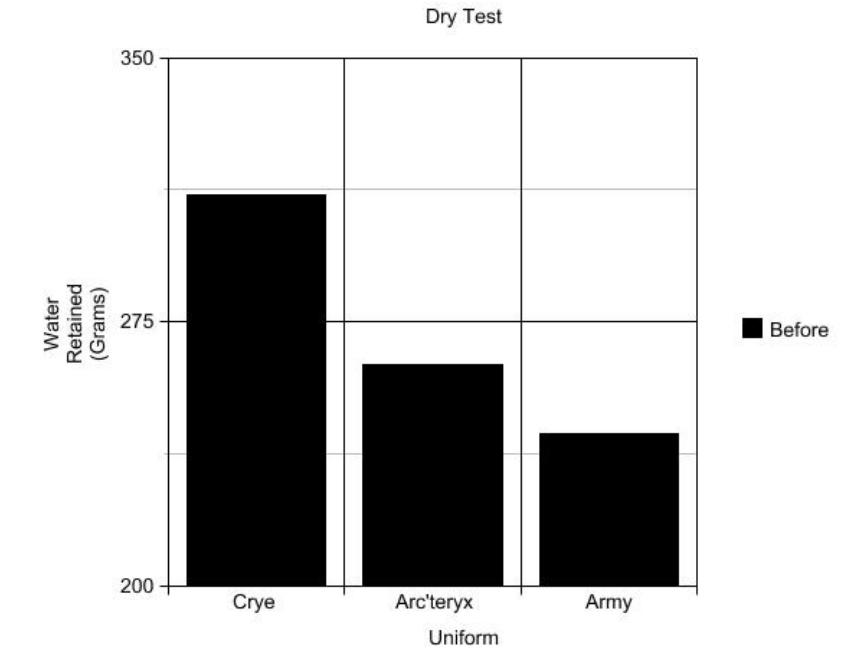
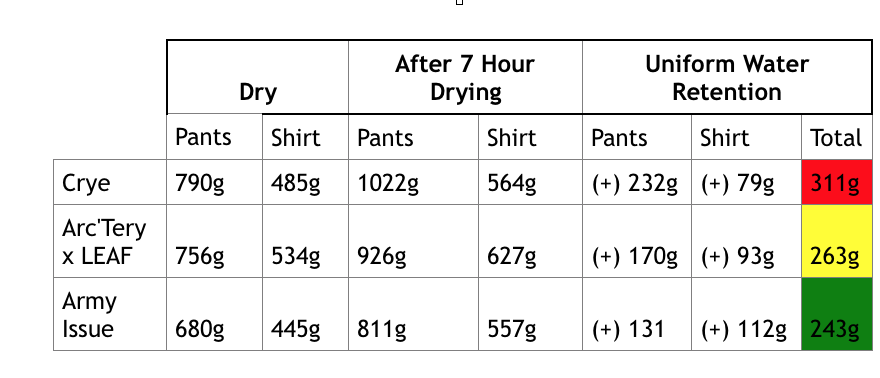
The Army issued uniform was the highest performer, allowing only 243g of water weight to be retained after being dried.
Arc’teryx LEAF placed second, with 263g of water retained.
The Crye Precision uniform retained the most water after seven hours, with 311g of water weight.
→ Winner: Standard Issue Army Uniform
2. Puncture Test

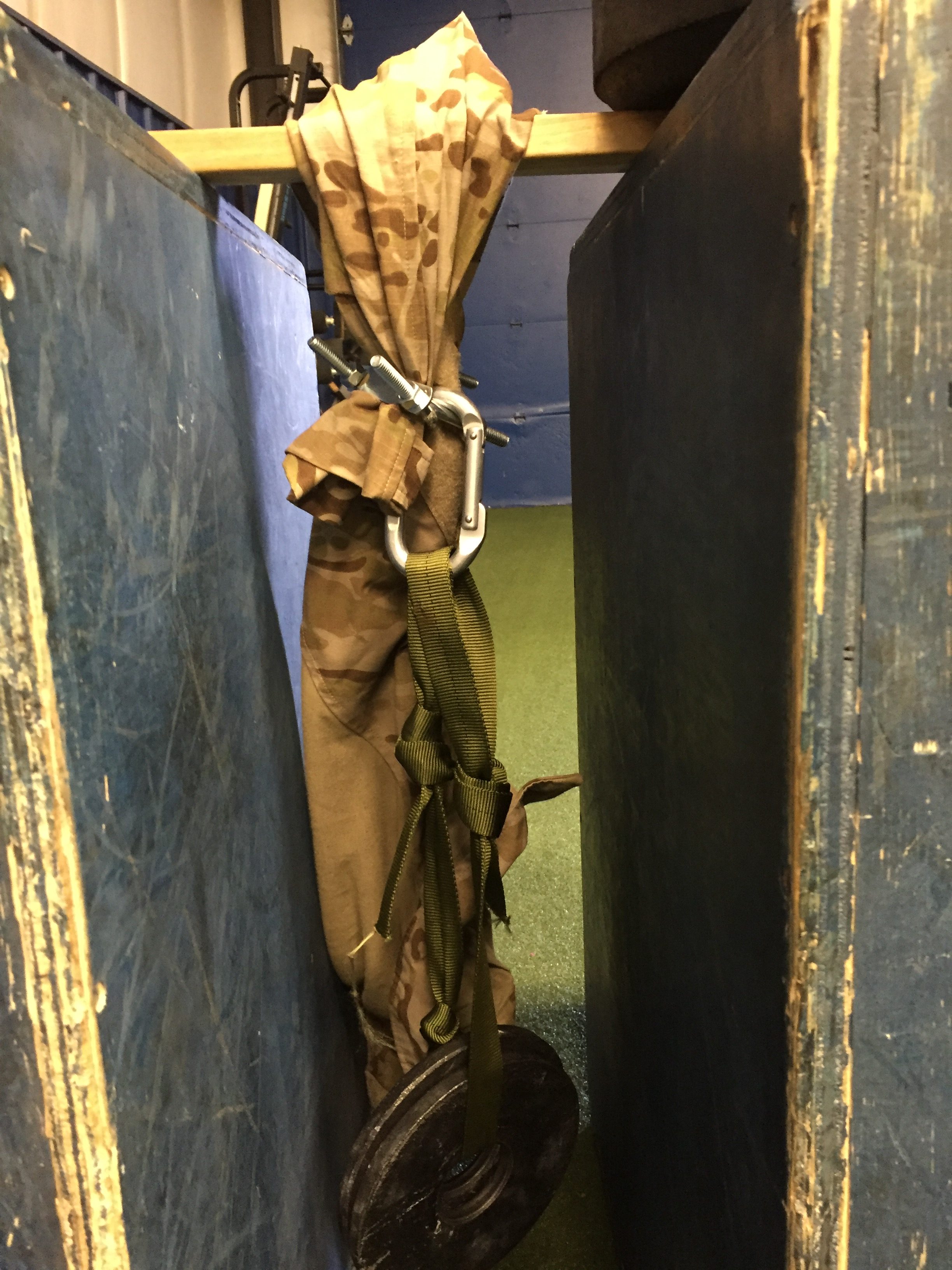
While moving through wooded, jungle, or urban environments, a multitude of objects can “snag” your uniform, creating a puncture point. While a small puncture hole is not immediately significant, the degradation of the uniform material makes it more susceptible to larger tears and rips. Through this test, we were able to determine which uniform material is least likely to be punctured, and therefore keeping it intact.
Methodology
The first test series of material durability was to determine the amount of weight required when pulled against a sharp object to puncture the uniform fabric. The puncture points were on areas of the uniform most likely to be snagged while worn – the exterior side of the shin on the pants and forearm on the shirts.
A 5-inch screw was drilled through a wood board. The board was placed on two large boxes so that the screw tip was facing upward, with the ends of the board secured by sandbags to ensure the board did not flip or move.
A large slit was cut through the back of the uniform pant and sleeve. A hose clamp was tightened above and below the designated puncture point, with a carabineer attached to both. The uniform material was placed over the screw, with the hose clamps hanging over both ends. A nylon strip was fashioned to secure to both carabineers, with 2.5 lbs. plates weaved through, increased one by one.
When the uniform material had been punctured to reveal the first thread of the screw, we determined the material to be punctured, and the uniform was removed from screw.
Results
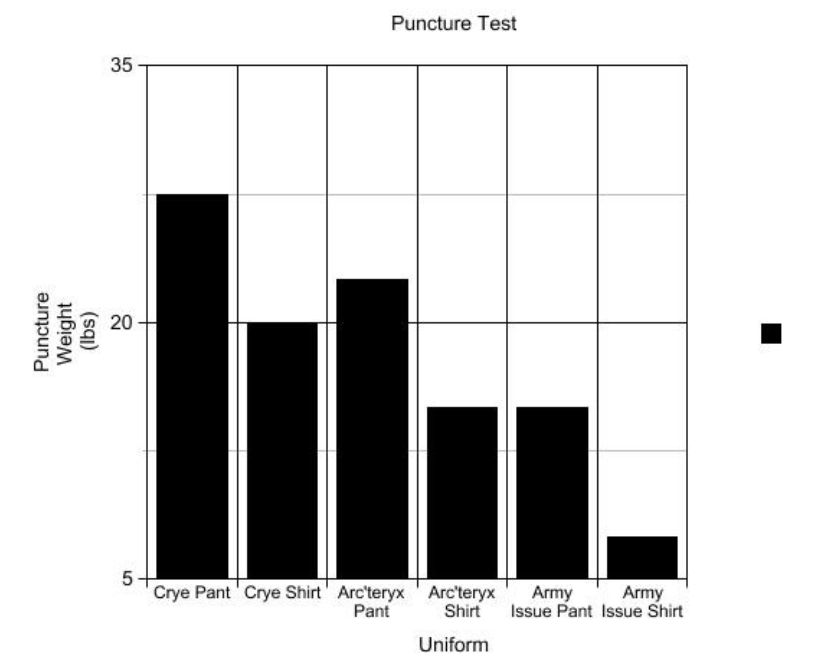
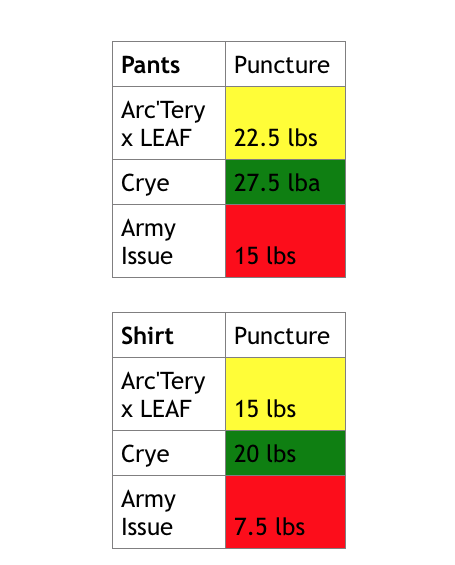
The Crye Precision uniform was the most resilient to puncture, requiring 27.5 lbs. of hanging weight for the pants, and 20 lbs. for the shirt.
The Arc’Teryx LEAF was second, requiring 22.5 lbs. for the pants, and 15 lbs. for the shirt.
Placing last, the standard issue Army uniform required only 15 lbs. for the pants, and 7.5 lbs. for the shirt.
→ Winner: Crye Precision
3. Tear Test
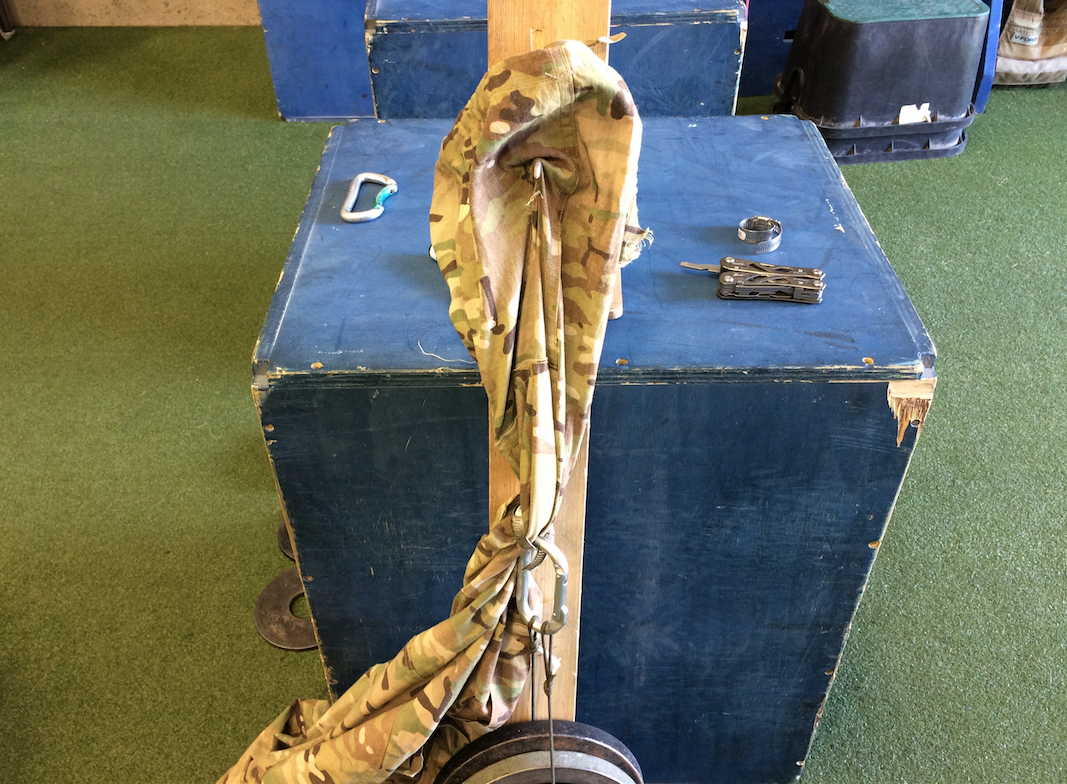
From the puncture point, comes the greater tear of the uniform. While the puncture is the initial contact with a sharp object, the tear is a result of the force of the soldier’s movement on the uniform with the object still through the material. Once the uniform has been significantly torn, the soldier is at greater risk to environmental exposure and skin abrasions or cuts.
Methodology
The same board with screw protruding was placed against the wall at a 30-degree angle. Utilizing the same puncture hole, the material was placed over the screw, with a clamp and carabineer secured to the bottom of the pant leg or shirtsleeve. Increments of 2.5 lbs. were hung from the carabineer. The measure was the amount of weight required to tear the material four inches from the puncture hole.
Results
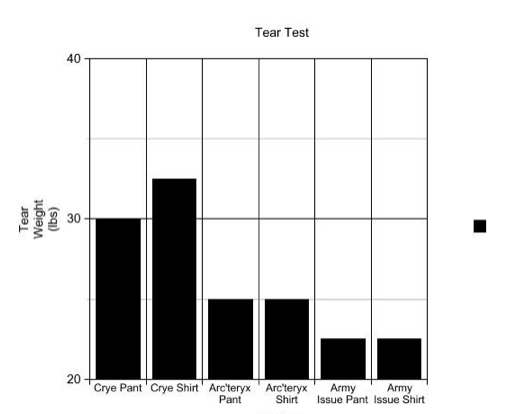

Crye Precision proved to be the most tear resistant. The pants required 30 lbs. to be torn four inches, and 32.5 lbs. for the shirt to be town four inches.
Arc’teryx LEAF was again second, requiring 25 lbs. to tear for both the pants and shirt.
Standard Issue Army Uniform was the easiest to tear, needing 22.5 lbs. for the pants and shirt to tear.
→Winner: Crye Precision
4. Crotch Seam Strength Test
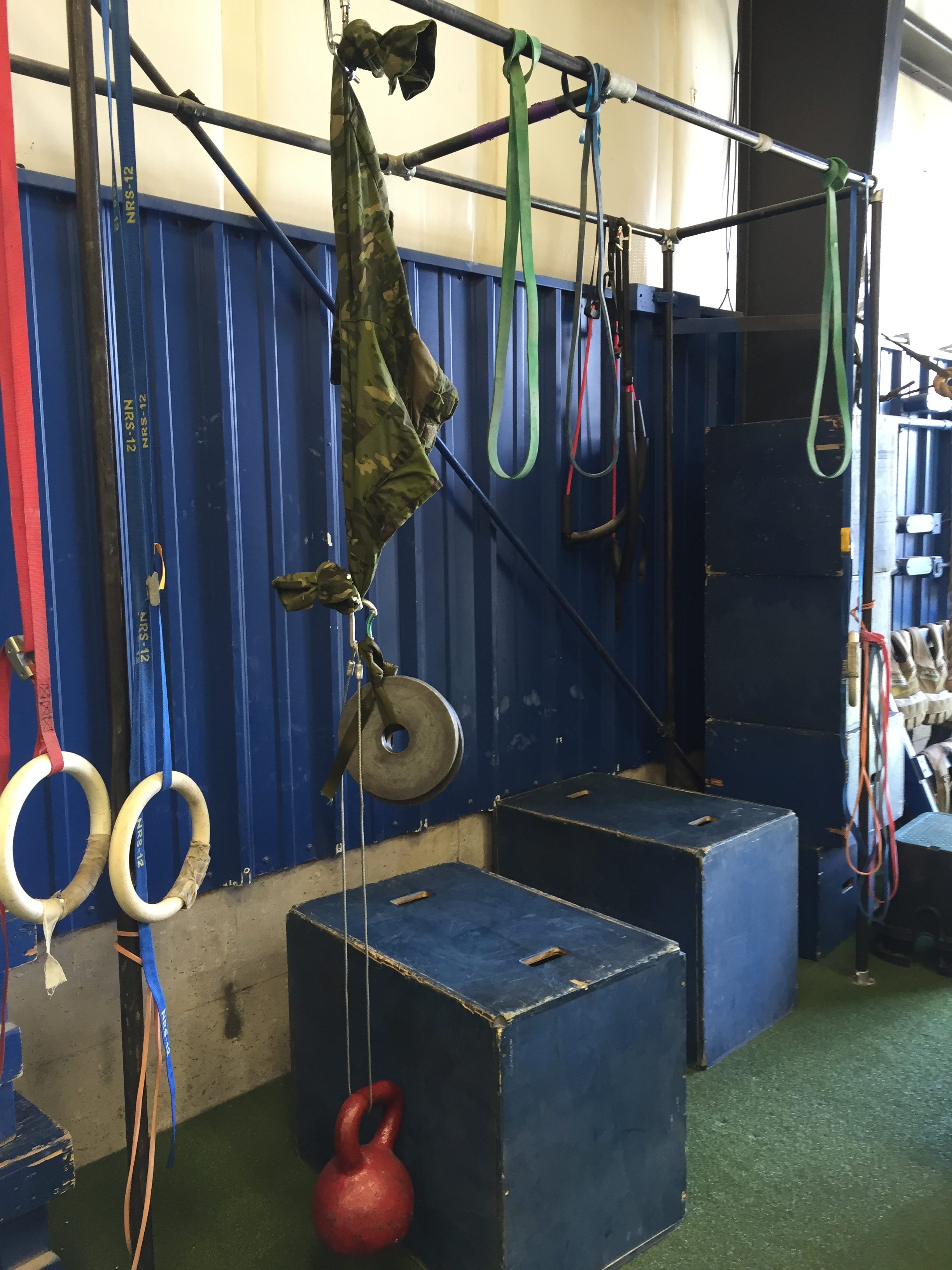
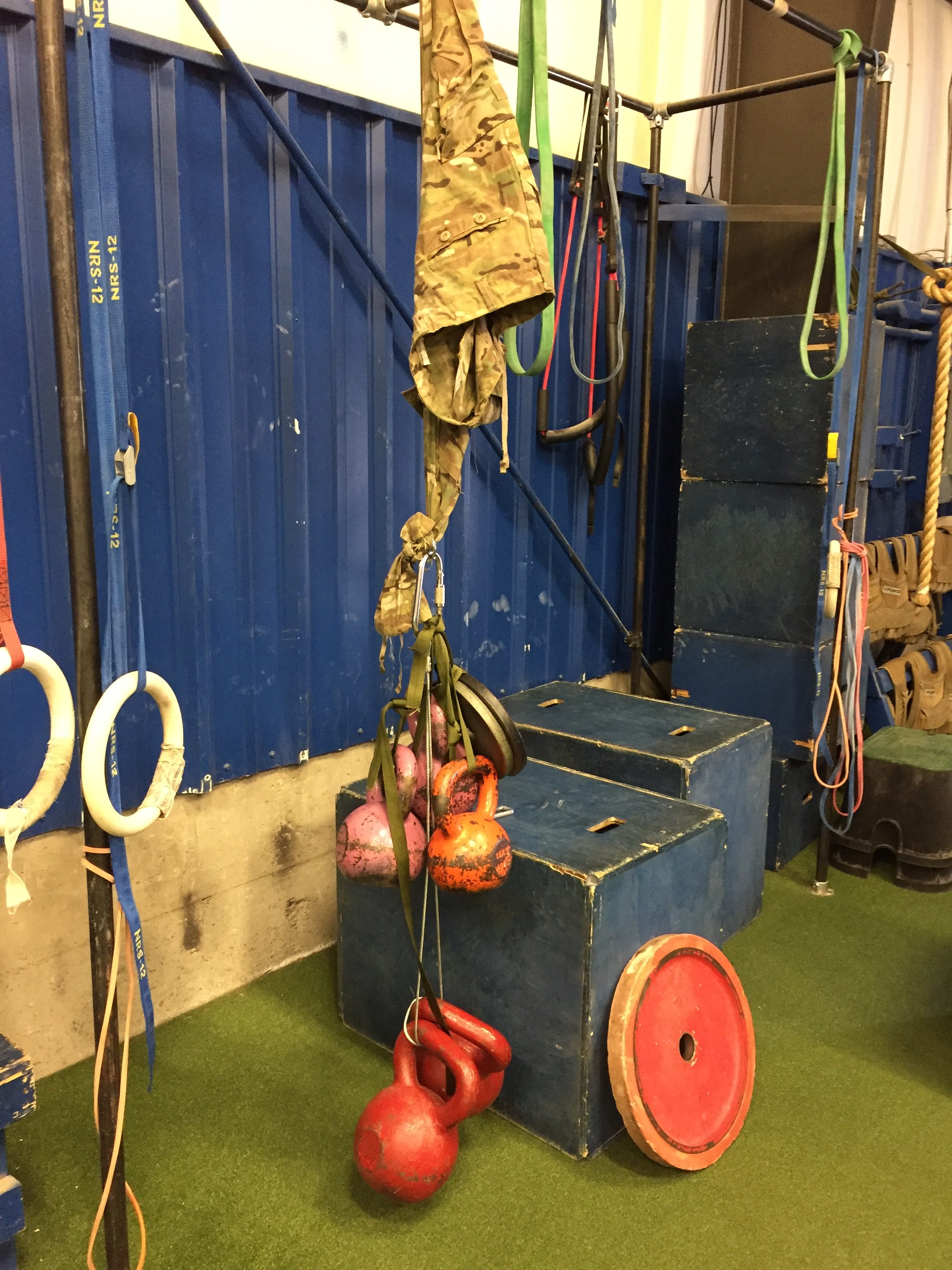
Every soldier likely knows the sound of the crotch ripping when taking a knee with a sustainment load weighing between 70 – 100 lbs. The “crotch blow out” is common, as much of the weight carried is placed on this area when kneeling, or moving from the prone to running.
Methodology
Clamps were placed on both legs of the pants, with large carabineers looped through the clamps. To ensure the clamps would not slide off the pants, each leg was tied into a knot around the ankle.
One pant leg was then suspended from a pull up bar, and weight hung from the other pant leg. The measure was amount of weight required to create a visible rip in the crotch seam.
Results
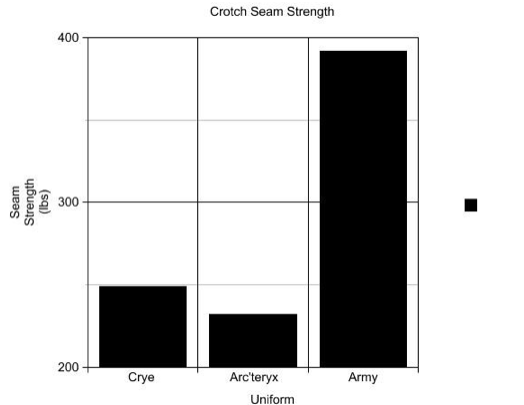
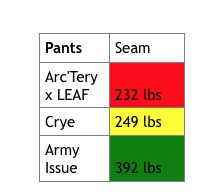
The Standard Issue Army Uniform was by far the best performer, requiring 392 lbs. before the crotch seam suddenly and completely tore.
Crye Precision was a distant second. The crotch seam also suddenly and completely tore at 249 lbs. suspended weight.
Arc’teryx was the poorest performer, with 232 lbs. required for a visible tear of the seam.
→ Winner: Standard Issue Army Uniform
5. Abrasion Test
Low crawling, high crawling, and a variety of other movements will create significant friction on the uniform as it is dragged across the ground. Over time, this can thin the material threads. The purpose of this test was to simulate this abrasion on the uniform material in a shortened period of time as the last component of our durability testing.
Methodology
Each uniform was placed beneath a five-inch circular sander for exactly 45 seconds to determine which uniform material would thin out the fastest. The uniform was measured with a digital caliper before and after the 45 seconds.
The least amount of difference between the two measurements was determined to be the least susceptible to wear due to abrasion.
Results
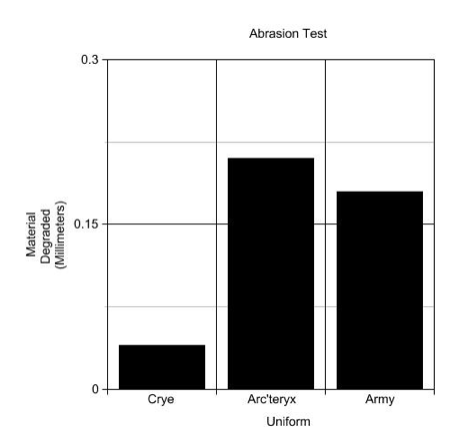
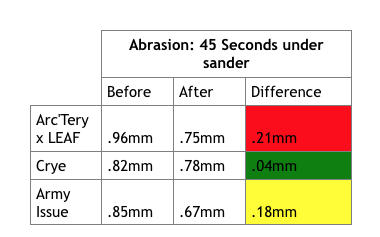
Crye Precision performance stood out for this testing, with only a .04mm difference after 45 seconds of sanding.
Standard Army Issue and Arc’teryx were very close, with the Army uniform coming in second at .18mm degradation, and Arc’teryx at .21mm.
→ Winner: Crye Precision
CONCLUSIONS
Based on our testing, the Crye Precision uniform proved to be the most durable across the spectrum of metrics assessed. Its performance was most resistant to puncture, tearing, and abrasion. It performed poorly in water retention compared to the other uniforms, but that would be an expected side of effect of building a uniform with the most durable material.
Arc’teryx LEAF placed second in our testing, although by a significant margin in comparison to Crye Precision on puncture, tear, and abrasion. Its results were similar to Crye on crotch seam strength and water retention. Interestingly, Arc’teryx LEAF price point is approximately $300 more expensive than Crye, depending on the vendor.
The standard issue Army uniform performed the worst of the three, although its performance on water retention and crotch seam strength was superior to Crye and Arc’teryx.
From a durability perspective, purchasing a Crye Precision uniform in place of what is issued to the individual soldier is challenging to quantify due to associated financial costs. If going into a situation where a soldier knows he will only have access to one or two uniforms for an extended period of time, then the purchase may be worthwhile. However, knowing that information ahead of time is unlikely.
Questions, Comments, Feedbacck? Email rob@militaryathlete.com
More Articles on this topic:
Combat Uniform Comparison Mini-Study: Crye Precision vs. Acr’teryx LEAF vs. Army Standard Issue
Crye Precision G3 Combat Uniform
Uniform Comparison Study: Crye Presicion GS (Fire Resistant) Week 1
Uniform Comparison: Evaluating Fit
